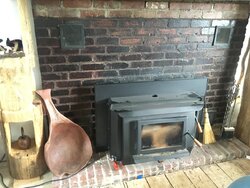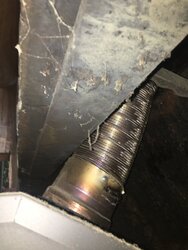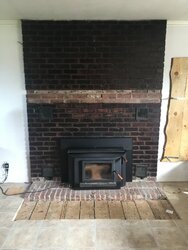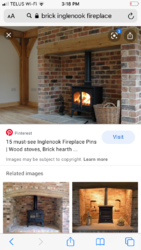Hi all, I’m looking for some help with my brick fireplace. It was constructed sometime in the mid 70s as part of an addition to the original house, prior to my ownership a blaze king insert was fit in the opening with metal cladding to conceal the rest of the opening. We would very much like to transition this to an inglenook design but here are my concerns.
1. I believe this is a heatilator design fireplace as there are four air vents ( I think we loose a lot of heat from these) and a metal firebox with warps and rust. I cannot find any identifiable indication to be sure it is a heatilator, where could I look?
2. It seems to me that the lentil is part of the steel structure? If this is the case would I be safe to grind it off from the inside and keep it in place while I grind out the rest of the steel insert?
3. I do not believe that the steel frame is supporting any of the brick structure but before I start cutting it away does anybody have any advice on how I could make sure this is the case?
I am thinking I should cut a hole in the roof of the firebox to use a camera to look around before proceeding . If all looks well since I will be making the opening larger for the inglenook design Should I then remove the row of bricks to my desired hight and install new lentil support row and proceed to remove the unwanted bricks and then remove the heatilator. Or remove the heatilator then do the brick resizing?
All advice is welcomed.
1. I believe this is a heatilator design fireplace as there are four air vents ( I think we loose a lot of heat from these) and a metal firebox with warps and rust. I cannot find any identifiable indication to be sure it is a heatilator, where could I look?
2. It seems to me that the lentil is part of the steel structure? If this is the case would I be safe to grind it off from the inside and keep it in place while I grind out the rest of the steel insert?
3. I do not believe that the steel frame is supporting any of the brick structure but before I start cutting it away does anybody have any advice on how I could make sure this is the case?
I am thinking I should cut a hole in the roof of the firebox to use a camera to look around before proceeding . If all looks well since I will be making the opening larger for the inglenook design Should I then remove the row of bricks to my desired hight and install new lentil support row and proceed to remove the unwanted bricks and then remove the heatilator. Or remove the heatilator then do the brick resizing?
All advice is welcomed.
Attachments
-
 0082213E-CCA3-4D5F-B0D9-BC41BF4A45C4.jpeg215.1 KB · Views: 137
0082213E-CCA3-4D5F-B0D9-BC41BF4A45C4.jpeg215.1 KB · Views: 137 -
 43A14840-7A49-4196-A0B5-0F7EC430F0D3.jpeg130.6 KB · Views: 130
43A14840-7A49-4196-A0B5-0F7EC430F0D3.jpeg130.6 KB · Views: 130 -
 50472C94-AA25-4451-A455-E93EC2EBD477.jpeg97.5 KB · Views: 123
50472C94-AA25-4451-A455-E93EC2EBD477.jpeg97.5 KB · Views: 123 -
 1D1F699C-0DA5-4348-A9DA-018EA63C7AEA.jpeg122.6 KB · Views: 141
1D1F699C-0DA5-4348-A9DA-018EA63C7AEA.jpeg122.6 KB · Views: 141 -
IMG_9533.MOV19.9 MB
-
 E8F98CB4-F11A-4C61-BB33-E46C62D13BBF.png649.1 KB · Views: 132
E8F98CB4-F11A-4C61-BB33-E46C62D13BBF.png649.1 KB · Views: 132

